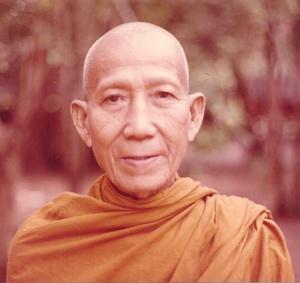The Art of Knowing Directly
The Art of Knowing Directly
"Don’t be united in anything other than developing awareness; be aware – pure awareness. Be aware in a straight and direct way, straight and direct SATI. Feel the body directly, in a straight way. Be fully aware: don’t let there be anything in front or behind. This is called really teaching [oneself].
Let awareness move around: let it be with the body, with RUPA. And let awareness see the mind. When there are thoughts don’t prevent or obstruct anything, give awareness the full opportunity [to see]. As for the body: know directly and straightly, know purely. Use and search for whatever ways that makes you have awareness within your body. Make it direct and straight, know immediately.
But some people don’t do it like this; before, I was the same myself: I didn’t know directly and straightly. I reserved it and knew other things and there were thoughts. Why do we do it like this? One goes and uses reasoning, figuring out what is right and what is wrong. ‘Like this is right’. There is like and dislike. Why do we practice like that? What’s the point of knowing this and that? For example, when we are aware, we ask ourselves, ‘Am I aware or not’? Is this SATI or not? Is this kind of knowing, awareness? Or is it thought? Sometimes we’re thinking and we don’t know what awareness is and so there is a division all the time. Reasoning and perceptions of right and wrong come to interfere with practice and so one doesn’t practice fully."
"KNOW, KNOW, KNOW, KNOW, BE AWARE
When you start off practicing you shouldn’t use reasoning and think about what is right and wrong. Don’t do it like that! Know directly, using whatever method that makes you be aware of either the body or the mind. Don’t concentrate. Don’t think about right and wrong before you experience right and wrong, don’t think about ‘being and seeing’ before you actually ‘are and see’. That’s not it! It is wrong when something is wrong, it’s right when something is right, you are when you are and you see when you see.
Be aware directly, don’t concentrate and don’t use reasoning. You shouldn’t think, from now on there is no need to think. When there is awareness of the body and the mind for a long, long period, seeing automatically occurs. This is not called thinking, it is called discrimination (DHAMMAVICAYA) or ‘orderly reflection’ (YONISO-MANISIKARA), it differentiates and wisdom-knowledge or wisdom arises by itself. This is called practicing directly"
~LOO-ANG POR KAMKEE-AN SUVANNO
Based on the teachings of Luangphor Teean
Source: WATCHING: NOT ‘BEING’







Comments
Nice post @Tony_A_Simien reminds me of Ajahn Sumedho's teachings on awareness.
Outstanding teaching.
Incontestable mindfulness. Direct awareness. No question.
The essence of the Hinayana is present and in that tight small wheel of knowing arises the Heart and Wisdom of the Mahayana. No room for name calling and traditional alliances.
If I had a flower I would raise it ... but that would just be showing off.
Cheers.
Good luck with that one! Ha!
^^^
Indeed.
The admonition to 'not think' might be more correctly stated as 'don't pontificate'.
The settled or 'not thinking mind' is still open to agitation but to a considerably lessened and eventually more subtle arising.
Don't you think?
This is the most basic foundation for vipassana practice.
With tranquility practices, calm, abeyance of suffering and stillness occurs as a result of sitting still, eyes closed or half open, being absorbed while isolated from the activity of regular life. It may be very necessary for some practitioners to start practicing this way. But if you intend to bypass tranquility meditation completely, these teachings are very useful.
With direct insight, there is also calm, abeyance of suffering and stillness. But this is different from tranquility induced by Samatha practices. In this case, calm, abeyance of suffering and stillness is a result of awareness being filled to the rim and overflowing. So full of bare perceptions is awareness that suffering, likes and aversions have no room to enter. Awareness is full and continuous. And even when they do enter they are just more objects for awareness. Then move on to the next object unattached to the last one.
So it's active investigation all the time and at the same time there is mental calm. There is no need to stop and fiddle around with concocting mind. Awareness has an endless supply of objects if you remain open and non intrusive. In the absence of intention awareness naturally flows from sense gate to sense gate without stopping. Activity is the name of this game. Calmness and stillness from within activity.
This thing always confuses me. Which comes first? Some say be aware and calmness will follow. Others say be calm and awareness will follow. Both seem to be right. For example, if your mind is jumping from one thought to another you cant be aware of anything. So in this instance calmness comes first. But in other cases awareness.
^^^
You can get to the Middle Way by both extremes.
Extreme calm or extreme awareness, so to speak.
We haz plan!
We're conditioned to repress our sort of primal awareness, which has a dampening effect on any calmness or still-mindedness. I don't think you can have one without the other.
This awareness, sati-sampajanna, intuitive awareness, is not something that I can claim personally. If my personality started claiming it, it would just be more self-view, sakkaya-ditthi again. If I started saying 'I'm a very wise person,' then it would be self-view claiming to be wise. So when you understand that, how could you claim to be anything at all? Of course, on a conventional level I'm willing to play the game. So, when they say 'Ajahn Sumedho' I say 'Yes'. There's nothing wrong with conventional reality either. The problem is in the attachment to it out of ignorance.
Once you see through self-view, the development of the path is then very clear. You trust in this awareness, in non-attachment. You are able to see that attachment is like this, non-attachment is like this. There's a discernment.
When you attach to things, really attach, so that you get the feeling of what attachment, upadana, really is. Don't just grasp the view that you shouldn't be attached to anything, because then you get attached to the view not to attach. So really be attached to being this, or to having a view; but observe attachment, really notice the power of attachment, upadana, of ambition, of wanting to get something, wanting to get rid of something. Make it fully conscious. And then once you really see attachment, you can inform yourself to let go of it. Let go. Let it be. So you are more accepting of things until they fall away. Of course, you can't keep anything, because things are always changing. Even if you delude yourself that you can keep something by holding on, you'll eventually see that that's an impossibility.
Finally in practice, we're left with the existential reality of our humanity. We've still got these primordial drives, sexual desire and anger. But now we know better than to make them personal. With sakkaya-ditthi, self-view, we're always judging our sexual desires, and our anger, hatred, aversion and fear, and making them very personal. But now we can look at them for what they are. They're energies, they're a part of being human, of having a human body and being in a sensitive and vulnerable space. We begin to see and understand the nature of lust, greed, anger, hatred and delusion, because we have taken the sakkaya-ditthi, the self-view out of it, the attachment to it on a personal level. We see that these energies arise and cease according to conditions. However, if you still haven't seen through sakkaya-ditthi, then your whole life you'll be celibate and feel guilty about sexual desire and anger and hatred. You'll become neurotic through identifying with those energies and forces that are in fact part of human reality, and are not personal.
We all have these primordial drives as human beings. They are common to all of us. They are not a personal identity. Our refuge is in awareness rather than in judging these energies that we're experiencing. Of course, our religious form is celibate, so when sexual energies arise, we're aware of them, and don't act on them. They arise and cease just like everything else. Anger and hatred arise and cease. When the conditions for anger arise, it's like this; likewise fear, the primal emotion of the animal realm. But the awareness of lust and greed, the awareness of anger, the awareness of hatred and fear, that is your refuge. Your refuge is in the awareness.
Ajahn
Sumedho
In order to build up awareness, I created many different exercises for myself.
I searched the internet for sound files. Rain, thunder, sounds of nature, traffic whatever I could get my hands on. Even sounds mind found annoying. I set them up to all play at the same time looping continuously.
I searched and gathered images online that mind found attractive, interesting and repulsive. I set that to play in slideshow mode.
I also had other sounds going around me in the apartment.
I would sit with eyes open relaxed. Looking at the screen. All of this noise coming from the computer and apartment. My only intention being to just relax the mind. Let go of the controlling mentality. Practicing to not control where awareness went. Just sit and let it flow to the sounds and sights without controlling them. That was the purpose. Practicing to be without volition. Learning by doing, to let go of that overwhelming urge to control attention. Watching And listening without judging and reacting. If I judged then that continuity of awareness without intention was broken. If I reacted, the same. I wanted to learn, to allow attention to flow without fiddling with it.
I bombarded the sense gates with sights and sounds that were pleasurable and annoying. Let awareness do its dance and just observe.
I had other exercises where I tensed up every muscle group in the body. One muscle at a time. This tensing allowed me to be more aware of sensations that I was normally oblivious too. I was training to feel every part of the body.
For example I would bend and tense the muscles in one finger. And continue this until I could feel every millimeter of it. Then I'd move to the next finger. Then the next. Until all were tensed and I could detect sensations in every part of my hand. When perceptions are bare, awareness moves much quicker. So it is possible to sense all at once. It's actually just awareness moving so quickly that the impression in mind is that you are feeling all at once.
I did this with every muscle in the body. We are typically very much oblivious to many sensations. We have to train to feel parts of our body regularly that we normally do not unless it's due to pain.
The most difficult part of this exercise was tensing of the entire body. And trying to sense sensations in every part of it at once. Some may think this is a bit extreme. But actually it's just using whatever we can to have awareness. The body is a very valuable tool. By practicing this way it became easier, without tensing the muscles, to be aware of more sensations during the body's normal activity. So awareness became more full. Thoughts, sensations, sounds, sights fill awareness in a panoramic way. All at once. Awareness is free from concepts so It functions faster than the speed of thought.
^^^ Good plan.
With the sound practice you mention; the response and discrimination between preferred noise/sound is very instructive. @Walker mentions the familiar yoga nidra practice in the next post post. Again a very worthwhile training also used in anger training, calming therapy techniques
Interesting that you mention tensing the entire body @Tony_A_Simien My yoga instructor had us do that right near the end of our Savassana (corpse pose) at the end of our classes.
Good thread. Knowledge from a monk. Personal modified practice.
Broadly speaking Dharma is a head downward path. In yogic terms the crown chakra is opened, thereby acccessing the other potential modes of knowing and the way to their cleansing.
The Heart is another way in, of which there are many. In dharma terms this means activation of love, devotion and surrender to the three jewels, ones lama or the Boddhisattva Saints directly.
The Sufis say it simply: 'increase in Love'. In Dharma we might say: Develop ahimsa, compassion, do good. Activate Friendship.
So basically the Satipatthana Sutta, MN10, foundations of mindfulness? It might be better just to reference the source text.
Here it is: https://suttacentral.net/en/mn10